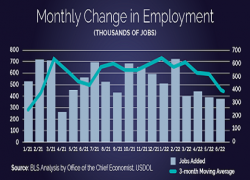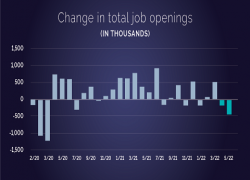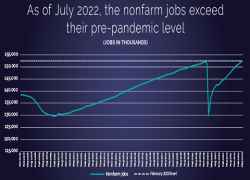As the economy continues to recover from setbacks related to the COVID-19 pandemic, people with disabilities have re-entered the labor force in greater numbers and have even surpassed the pre-pandemic level. This encouraging trend improves the historically persistent, substantial gaps between workers with and without disabilities. Structural changes in business practices prompted by the pandemic, such as greater flexibilities in work schedules and more opportunities to telework, may have opened additional opportunities for workers with disabilities who had fewer such opportunities in the past.
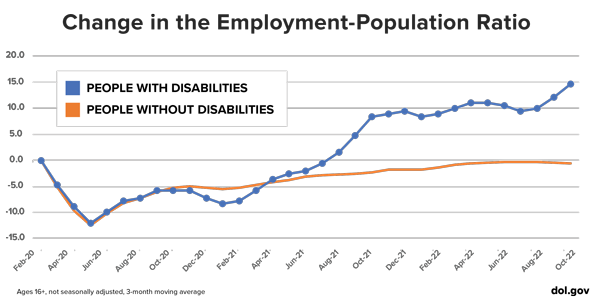
Following the onset of the pandemic restrictions, from February 2020 to April 2020, the employment-population ratio declined similarly for people with and without disabilities. The employment-population ratio for people with disabilities aged 16+ declined from 19.1% in February 2020 to 17.4% in April 2020, a reduction of 8.9%; for people without disabilities, the decline was from 65.9% to 59.5%, a similar reduction of 9.7%. For the age-range 16-64, the declines were similar at 8.0% for people with disabilities and 7.8% for people without disabilities. The employment-population ratio for people with disabilities fully recovered in August 2021 at 19.4% and has remained above its pre-pandemic level since; the ratio for people without disabilities has not yet recovered but has been at or above 65% since February 2022. The employment-population ratio for all workers ages 25-54 is at its pre-pandemic ratio. (These data are 3-month moving averages centered on the month of analysis.)
Although both employment and labor force participation rates improved for disabled workers in 2021, people with disabilities continue to experience significantly lower rates of employment and labor force participation than those without disabilities.
How Has COVID-19 Impacted Disability Employment, a recent paper published by the National Bureau of Economic Research notes that the expansion of telework may have contributed to the increased employment among disabled workers. A brief published by the Department of Labor’s Office of Disability Employment Policy, Employment of Persons with a Disability: Analysis of Trends during the COVID-19 Pandemic, also supports this hypothesis. Importantly, a disproportionate share of people with disabilities are still employed in occupations that are less amenable to telework, such as production, transportation, material moving and service jobs.
Employment shares by gender
The pandemic downturn and recovery exacerbated gender inequities in the labor market. While those inequities are still reflected in the lower employment share of women with disabilities relative to men with disabilities, women’s employment share has picked up in recent months. The employment-population ratio for men ages 16-64 with disabilities fully recovered in July 2021 at 33.2%. Among women ages 16-64, the employment-population ratio for those with disabilities fully recovered in April 2021 at 29.7%. In recent months, this ratio for women with disabilities has been nearly one-fifth higher than it was prior to the pandemic.
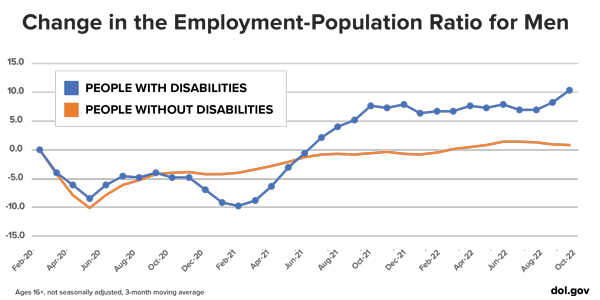
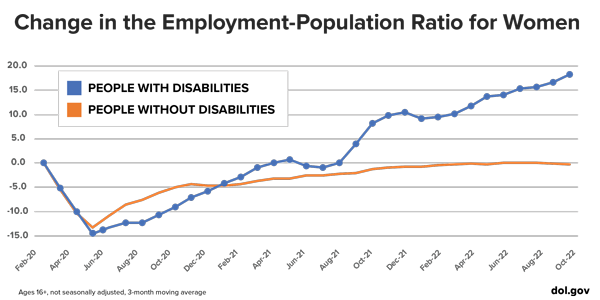
While the trends in the employment-population ratio of people with disabilities are encouraging, significant gaps in labor force participation and employment persist between people with and without disabilities. Closing these gaps is essential to not only America’s continued economic recovery, but also its ongoing progress toward a more inclusive and equitable workforce. Through the Department of Labor’s Office of Disability Employment Policy (ODEP), we promote inclusive and equitable employment policies that consider the needs of all workers through collaboration with employers, and state, local and tribal governments.
The Department of Labor helps all Americans who want to work find work by helping them access the services and supports they may need to do so, from training and employment assistance to workplace accommodations that facilitate success once on the job. We will continue to fight for equal treatment of all Americans in the labor market as the labor market transitions from a period of recovery to steady growth.
Joelle Gamble is the chief economist for the U.S. Department of Labor. Megan Dunn is a senior economist at the Bureau of Labor Statistics. She is currently on detail to the Office of the Chief of Economist.

 U.S. Department of Labor Blog
U.S. Department of Labor Blog
